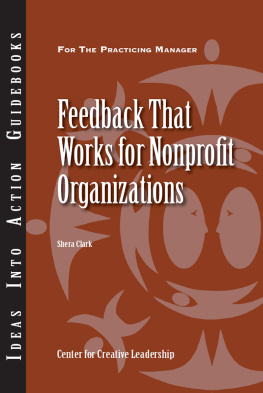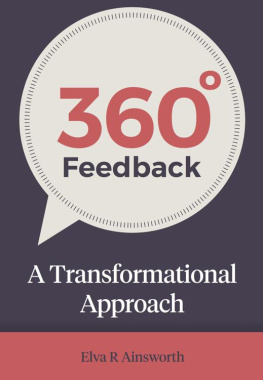Contents
Guide
Leveraging
the Impact of
360-Degree Feedback

Leveraging the Impact of 360-Degree Feedback, Second Edition
Copyright 2020 by Center for Creative Leadership
All rights reserved. No part of this publication may be reproduced, distributed, or transmitted in any form or by any means, including photocopying, recording, or other electronic or mechanical methods, without the prior written permission of the publisher, except in the case of brief quotations embodied in critical reviews and certain other noncommercial uses permitted by copyright law. For permission requests, write to the publisher, addressed Attention: Permissions Coordinator, at the address below.

Berrett-Koehler Publishers, Inc.
1333 Broadway, Suite 1000
Oakland, CA 94612-1921
Tel: (510) 817-2277, Fax: (510) 817-2278
www.bkconnection.com
Ordering information for print editions
Quantity sales. Special discounts are available on quantity purchases by corporations, associations, and others. For details, contact the Special Sales Department at the Berrett-Koehler address above.
Individual sales. Berrett-Koehler publications are available through most bookstores. They can also be ordered directly from Berrett-Koehler: Tel: (800) 929-2929; Fax: (802) 864-7626; www.bkconnection.com
Orders for college textbook/course adoption use. Please contact Berrett-Koehler: Tel: (800) 929-2929; Fax: (802) 864-7626.
Distributed to the U.S. trade and internationally by Penguin Random House Publisher Services.
Berrett-Koehler and the BK logo are registered trademarks of Berrett-Koehler Publishers, Inc.
Second Edition
Paperback print edition ISBN 978-1-5230-8835-5
PDF e-book ISBN 978-1-5230-8836-2
IDPF e-book ISBN 978-1-5230-8837-9
Digital audio ISBN 978-1-5230-8838-6
2020-1
Book producer: Westchester Publishing Services
Cover and text designer: Kim Scott, Bumpy Design
Contents
by Cynthia D. McCauley
CHAPTER 1
Purposes and Uses of 360-Degree Feedback
CHAPTER 2
Using 360-Degree Feedback for Talent Management
CHAPTER 3
Characteristics of the 360-Degree-Feedback Process
CHAPTER 4
Implementing 360-Degree Feedback
CHAPTER 5
Facilitating 360-Degree Feedback
CHAPTER 6
Factors Affecting the Validity of 360-Degree Feedback
CHAPTER 7
Avoiding Common Pitfalls of 360-Degree Feedback
CHAPTER 8
The Future of 360-Degree Feedback
Foreword
Feedback as an essential element for leader development is deeply rooted at the Center for Creative Leadership (CCL). Early architects of our leader development programs were big proponents of experiential training in which individuals were observed and given feedback. The Situation-Behavior-Impact framework for providing actionable feedback to others is a staple across our leader development portfolio. Way back in 1978, CCL published its first review of available instruments for providing systematic feedback to managers, which at that time was primarily upward feedback from employees to bosses. Thus, it should be no surprise that CCL has been at the forefront of research, design, and delivery of 360-degree feedback.
Today, 360 feedback is a well-known and often used tool for development. It has the potential to provide a unique level of clarity about ones strengths and areas for development and to motivate efforts to change and grow. Yet implementing 360 feedback in an organization is complex. There are numerous design choices to make, trade-offs to consider, details to pay attention to, pitfalls to avoid, and people to have on board. Doing it right has its payoffs: a process that generates credible feedback and encourages participants to change troublesome behaviors, develop new skills, or strengthen critical relationships.
I cant think of a better trio of colleaguesJohn Fleenor, Sylvester Taylor, and Craig Chappelowto advise and guide your efforts to implement an impactful 360-degree feedback process. Together they bring deep knowledge of 360 feedback research, expertise in feedback instrument design, and years of experience in both facilitating feedback sessions with individuals and helping organizations design and improve their overall 360 feedback processes. And all this put together in a practical, straightforward guide.
In this second edition of the book, you can anticipate being treated to the latest insights and experiences from the field. For example, integrated talent management processes are the expectation these days. What role does 360 feedback play in talent management? And digital transformation is on every organizations radar. How will leader assessment and feedback take advantage of all this new and powerful technology? Just when we thought we had our arms around 360 feedback, we are being pulled in new directions, and theres more to discover.
Cynthia D. McCauley
Senior Fellow
Introduction
For todays organization, creating and maintaining a high-performing culture is a critical concern. For organizations striving to maintain these cultures, providing accurate and relevant feedback to leaders is a key issue. The most valuable tool for providing feedback to leaders is 360-degree feedback. Known also as multirater or multisource feedback, 360 feedback has become one of the most significant innovations in the leadership development field (Chappelow, 2004). It has been called one of the most notable management innovations in recent times (Atwater and Waldman, 1998). Since the late 1980s, 360 feedback has gained increasing acceptance and significance in organizations (Dutton, 2019; Silzer and Church, 2009).
About This Book
As one of the original architects of 360 feedback during the mid-1970s, the Center for Creative Leadership (CCL) has made significant contributions to its theory and practice. The approach wasnt known as 360 feedback back then, but since that time, CCL has provided 360 feedback for over 1.2 million participants involving over 10 million raters. The guidance in this book draws on the lessons learned through research and practice at CCL, who has partnered with thousands of clients to deploy 360 feedback processes in their organizations, both large and small, around the world.
This publication represents the second edition of Leveraging the Impact of 360-Degree Feedback (Fleenor, Taylor, and Chappelow, 2008). It presents an updated perspective of CCLs vision of how to successfully implement a 360 process in an organization. While there are other successful methods for implementing 360 feedback, we will focus on how to optimize 360 feedback when used for leadership development purposes. The recommendations in this book provide guidance based on CCLs research and practice and the experience of our clients.
The second edition of Leveraging the Impact of 360-Degree Feedback is designed to update advances in the field during the past 10 years. In addition to revising the treatment of each topic in the chapters, we have added four new chapters: Using 360-Degree Feedback for Talent Management, Factors Affecting the Validity of 360-Degree Feedback, Avoiding Common Pitfalls of 360-Degree Feedback, and a dedicated chapter on the Future of Leader Assessment, which is a current stream of research at CCL.










